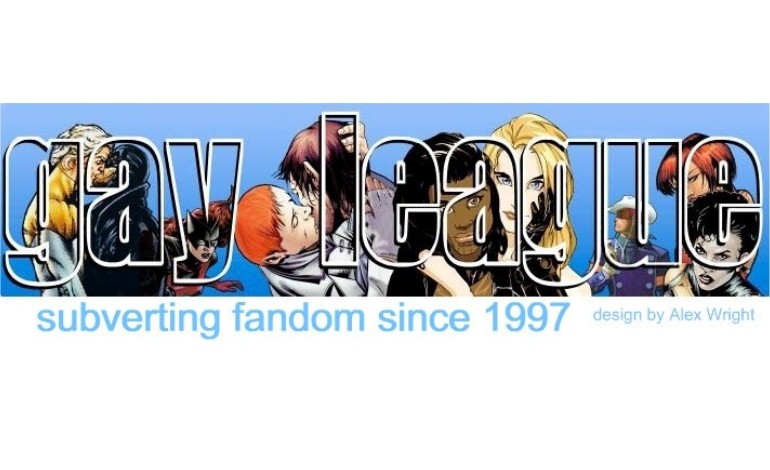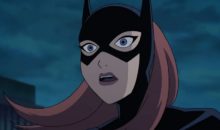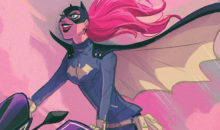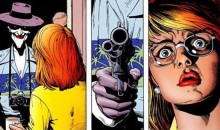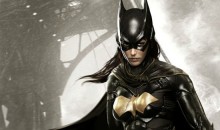Community Spotlight: Gay League
“Gay League” is a community of comic book nerds, specifically of the superhero genre, who identify as members of or ally to the LGBT community. Over time it has transitioned from a loose gathering of like-minded fans on DC’s message board, to a comprehensive database of LGBT characters, and an ongoing social media gathering place. The community is moderated and guided by one of its earliest members, J L Palmer, who I had a chance to talk to recently about the community he helped build.
Hope: How did Gay League begin?
J L: Gay League’s origins began sometime in 1997 on DC Comics’ original message boards hosted by AOL. A few gay comics nerds started posting about comics from a gay comics nerd point of view and started to attract attention. Whoever wrote the first comment is unknown because the moderator had a habit of deleting comics she felt were off topic. Some straight guys weren’t very friendly and willing to share the forums either. That first, small handful of guys decided to form a proto email group where they could really talk about comics from a gay perspective, while at the same time staying involved in the DC boards as a means to find more likeminded nerds. That’s where I came in, after spotting a really camp post and working up a little nerve to contact the writer to ask what was going on. We grew a little at a time and while things were informal, a new sort of structure started to emerge. A few of us used our “free member space” that AOL offered to put together the beginnings of a website and at around the same time took our little email group public and that’s when it felt like things were really beginning to take off. At first, and I hate to admit this, I had my reservations about becoming visible, but that changed when I realized nothing terrible would happen. Those big changes were the ideas of Anton Kawasaki, who sort of became a leader when no one else really wanted, and Drew Moore who designed the graphics for our fledgling presence.

‘Queen Team’ Logo by Drew Moore
In those very early days we referred to ourselves as “Gay O League”, then as “GLA” or “Gay League of America” in a mashup reference to both AOL and DC Comics’
Justice League of America (or JLA). At least we dropped “America” from the domain name. We weren’t really forward thinking about the names, were we?
So, we started with the purpose of being a community and I’d like to think we are still.
Hope: Tell me a bit about your history as a comic book fan
J L: Oh lord! Here’s where I really date myself. My first memory of comics is spying on another boy in my first grade class reading an issue of Adventure with the Legion of Super Heroes. That would’ve been 1964. In the next several years I watched lots of the 1950s

Adventure Comics #247
Superman, and Batman, and Green Hornet till one summer day in 1967 I’d gone grocery shopping with my mom (as if I had a choice) and begged her to buy me a comic which just so happened to be another issue of Adventure. That was all it took for me to be smitten and I begged and saved every bit of birthday money.
There was also a stack of comics from the 1950s that I discovered at my grandparents’ house. They’d belonged to my mother but they weren’t interesting to me since they were western and humor. The older brother of a good friend in high school was the first person I met who was also a comic fan. He decided to stop reading them and sold me his collection, so that’s how I lucked into a lot of Silver Age comics, mostly Marvel. It wasn’t till I was in my early 20s that I really began to understand there was some kind of community when I stepped foot inside my first comic shop. That was a far cry from newstands, drug stores, and old Mrs Stuan’s second hand shop where sometimes I could find not so old comics for a nickel.
So, in a sense I’m a dinosaur fan boy though I don’t mind change!

Wuvable Oaf by Ed Luce
Hope: What characters/storylines do you feel a particular connection with?
J L: The one character who has really affected me is Barbara Gordon as she was transformed and written by various writers post Alan Moore’s The Killing Joke. Letting the character slide into limbo would have been an easy thing to do. I also really adore Ed Luce’s Wuvable Oaf because it’s really well written and drawn and Wuvable Oaf didn’t give up on finding love despite past bad experiences and some big obstacles.
Hope: I admit, I find it interesting that you chose Batgirl as one that connected to you, instead of Batwoman! I love the idea of a comic book featuring bears though, I will definitely pick that up. Do you feel a particular connection to any mainstream LGBT comic book hero?
J L: Oh, don’t get me wrong. I love Batwoman as she’s been re-imagined by Greg Rucka, J H Williams and everyone else who’s worked on the character. Batwoman is one of the comics I look forward to reading when it comes out. Apollo and Midnighter come to mind, and people always point out how violent and murderous the stories are. And they are. What I like about the couple is that they’ve always been there for one another (not counting the half-assed editorial decision the Midnighter solo series had to exclude Apollo). Northstar hasn’t been a character that appealed much to me. That is until the character was paired with business manager and love interest and later husband Kyle Jinadu. And more than 15 years later I still remember the issue of Starman in which James Robinson very simply and lovingly revealed that another character sharing the titular name was in love with a man named Tony. I remember actually crying when I turned the page to see them kiss.
Hope: Are any comic book artists/writers aware of the Gay League community?
JL: Phil Jiminez was involved from a social aspect and early on he designed a logo for the site which we used for a while. The social aspect was informal weekly gatherings of Gayleague members who lived in New York. People would meet somewhere, I think there was a food court that became a popular spot for get togethers, and talk about comics, movies, and lots of other topics. A few years the guys in New York planned these “GLA Convergences”. They were a weekend packed with lots of activities like bowling, trivia contests, scavenger hunts, and they usually ended late at night at a bar. One time there was a tour of DC Comics’ offices.
Gail Simone has been supportive of the group. She first joined Gayleague some years ago when the email list version was going strong and then found us on Facebook. She very thoughtfully sends new people our way and it’s much appreciated.
Patty Jeres, Ed Luce, Dale Lazarov, Carla Speed McNeil (who’s an ally), and Jon Macy are people who come to mind who’ve been involved or supportive, each in their own ways. Apologies to others — and I know there are — whose names escape me now. Curse my bad memory!
Hope: What one comic-book with LGBT content would you recommend for a teenager?
JL: Two titles come to mind right away. The first is Marvel’s Young Avengers, especially I think the last volume from Kieron Gillen and Jamie McKelvie. True, there’s a history and back story to the characters, but I think the LGBT youth would key in on the tone. Then they can go back and pick it up from the beginning. Try the local library for copies!

FF #6, art by Mike Allred, story by Matt Fraction
Archie Comics’ Kevin Keller is the other suggestion. Archie is a beloved comic for many, but I was never one who had any interest in the Riverdale Gang. If I looked at an Archie comic as a kid it was out of sheer boredom while waiting at the doctor or barber shop. That’s my confession. What Dan Parent has achieved with Kevin as a character is amazing and has consistently broken all of my jaded predictions, such as Kevin would never have an on panel boyfriend, let alone share a kiss. Mainstream publishers have a problematic history with trans characters. While I’ve not yet read it, Matt Fraction and Michael Allred got a lot of praise for their portrayal of a trans character in FF from Marvel. (That’s just FF, not an abbreviation for Fantastic Four.)
Hope: If you had any advice for LGBT youth growing up, what would it be?
J L: I would tell them that they’re not alone despite they’re feeling that way. I felt the same way growing up in a small farming community until I reached my late teens. And never believe bullies and negative messages about being LGBT, and please never to give in to despair. You are as deserving of love, respect, and dignity as everyone else.
Hope: Tell me about any particular positive memories associated with building the gay comics community.
J L: Certainly all the people over the years I’ve met and come to know is wonderful! And as “Golly! Gee whilikers!” hokey as this sounds, I really like being involved in this comics niche and the intersection of fans and indy/small press and mainstream writers and artists.
Hope: How has LGBT presence, either in the comics or in the fan community, changed over the years?
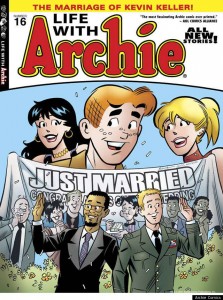
Kevin Keller
J L: Things have changed so much in the fan community! Unless you’re a comics newbie, I think everyone knows now that exist and we read and love comics as much as everyone else. We’re all over social media, and comic cons with LGBT panels and PRISM and various artists and writers have tables. There’s even the Bent Con comic convention geared specifically for LGBT fans!
Representation has changed a lot and for the better in comics too though there is still lots of room for improvement. Marvel and DC have become more inclusive and supportive, whether it’s Batwoman or Northstar, yet LGBT characters that appear today are typically still playing parts as supporting cast or as part of a team. Archie Comics has had amazing success with Kevin Keller, more than I think even Dan Parent or Archie’s publishers may have thought was possible. Yet I can’t help wondering how many years till DC or Marvel decides to try a solo series featuring a gay male?
Someone reading this may be thinking “What about that Midnighter comic?” It’s true, there was a Midnighter solo some years back from Wildstorm. After issue #8 or #9 Midnighter seemed mostly neutered and cut off from any interaction with Apollo. When LGBT characters are in supporting or ensemble roles they run the risk of being written out of the book when a new writer or editor comes in or disappear into limbo if a series is cancelled. True, these are also possibilities that often happen to straight characters, though a significantly higher number of straight characters headline series. Sometimes there seems me to be a cycle of advancement, status quo, and then a step or two backwards when a series with an LGBT cast member or two is cancelled. And I don’t blame publishers for being conservative with their resources and money, but, damn if it isn’t frustrating.
Hope: What do you see as the future of Gay League?
J L: As far as we could tell back then we were the first gay comics fan site. Obviously that’s changed. The only other resource we knew of back in the beginning that covered comics from a gay interest was Beek’s Books, which I remember mainly for reviews of some gay comics. I’d like for the community to really thrive, not necessarily grow exponentially. Not that being a large community is bad, though it makes fostering a sense of place or of family really challenging if not impossible.
Also, I’d very much love to see more participation from people of various sexual orientations and gender identities. I’ve not been very successful to date with that goal, so I’m open to suggestions!
—
Sound like the place for you? Read all about the history of gay superheroes and their publication history at gayleague.com, or join the discussion at https://www.facebook.com/groups/gayleague/
Thanks to J L for helping to maintain a safe space for nerds of all sexual orientations to geek out about their favourite characters.

